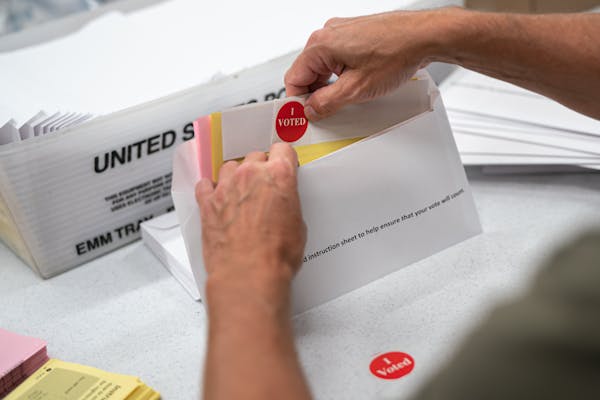Minnesota's top election official issued a strong defense of the state's safeguards for absentee voting Wednesday, one day after President Donald Trump questioned the integrity of mail-in ballots during the first presidential debate.
"The system is safe, secure and time-tested," Minnesota Secretary of State Steve Simon said. "This has been a system that has worked very well, successfully and securely, for decades." Simon noted that Minnesotans have voted absentee since before World War II.
Trump's remarks came during a contentious 90-minute debate in which the president cast doubt on the upcoming presidential election, asserting despite an absence of documented cases that mail-in ballots will be "manipulated."
"This is going to be a fraud like you've never seen," Trump said Tuesday night.
Trump singled out states that proactively send ballots to all registered voters, whether or not they request them. A number of states, including some led by Republican governors, have the sort of universal mail-in voting Trump has criticized. But Minnesota does not.
Minnesota adopted no-excuse absentee voting in 2013, allowing residents to register and cast ballots early by mail. Since then the option has grown in popularity. Florida, where the president votes by mail, has a similar system.
While most voters in Minnesota must request mail-in ballots to vote from home, some small towns in rural counties conduct their elections entirely by mail. More than 220,000 Minnesota voters live in precincts that use automatic mail-in voting.
Critics say the president's comments questioning the legitimacy of this year's elections could undermine voters' confidence in the democratic process. In Minnesota, four in 10 likely voters believe mail-in ballots are vulnerable to significant amounts of fraud, according to a recent Star Tribune Minnesota Poll. Half believe sufficient safeguards are in place, the poll found.
Minnesota Republican Party Chairwoman Jennifer Carnahan said that while she shares some of the president's concerns about universal mail-in voting, she believes Minnesota's system includes sufficient safeguards.
The party encourages supporters to use whichever of the state's three options they prefer this year, whether that means casting a ballot by mail, early in person or at the polls on Election Day.
"Our absentee ballot system that we have, we have confidence in that," she said.
Nevertheless, Carnahan said she has fielded questions from GOP voters who are concerned or confused about the process. But she doesn't blame Trump.
"I don't think the president is sowing seeds of distrust," she said. "The president is saying things that people have been thinking. It's been on people's minds long before he was president."
State and local election officials say there are few documented instances of fraud related to voting in the state, thanks in part to checks and preventive safeguards. When requesting a ballot, for example, voters must provide either a driver's license number or a partial Social Security number. That information is also required as part of the return envelope to thwart others from stealing ballots or submitting them using false identities.
"Only if the return ballot contains that exact same identifying information will that ballot be accepted," Simon said.
Trump raised several other concerns with the voting process in Tuesday's debate. He questioned plans to count ballots after Election Day, arguing that it could delay the final outcome and could open the door to fraudulent counts.
In Minnesota, a deadline for receiving and processing ballots postmarked Nov. 3 was extended to seven days after the election. State officials have cautioned that the extra time may mean close races are not decided on election night. But the rule for accepting late ballots is under legal challenge by Republicans.
State election officials also can take ballots out of inner privacy envelopes and run them through a tabulator machine starting 14 days before the election, though the results themselves will not be calculated until the polls close Nov. 3.
Some states prevent election officials from opening and processing mail ballots until Election Day.
The president also called on supporters to flood the polls to watch for irregularities on Election Day. Simon urged Minnesotans of all political persuasions to ignore that request.
State law allows one observer for each major political party inside a given polling site. Those poll watchers can challenge ballots based on "personal knowledge" of potential fraud or wrongdoing, Simon said, but not on a "hunch or a feeling or a bad vibe or a guess." Additional observers and anyone not there to vote will be turned away.
"The polling place is supposed to be an oasis to voters, a place where they can quietly and thoughtfully exercise their right to vote free of electioneering and distraction and intimidation," Simon said.

Trail section at one of Minnesota's most iconic spots closing for rehab

Will 'shotgun only' zone for deer in southern Minnesota be abolished?

Four Minnesotans catch salmonella in outbreak linked to basil sold at Trader Joe's

